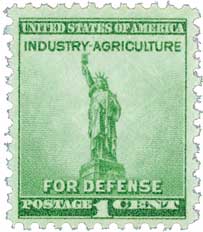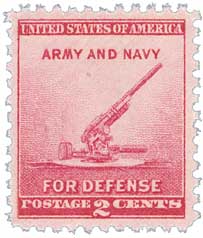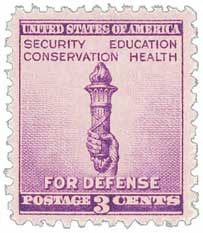

Happy Holidays! Enjoy a FREE 2026 Stamp Calendar With Purchases of $100 or More. While Supplies Last

On October 16, 1940, the US Post Office Department issued a set of three stamps to raise support for a strong national defense.
By the summer of 1940, Americans wanted nothing to do with the European conflicts overseas, holding tightly to their isolationist ideals. The only aid President Franklin Roosevelt could provide (as Congress refused to pass any military bills) was repealing the arms embargo to allow the US to sell arms to Great Britain. Britain was required to pay in advance and transport the material back on their own. However, German ships sank the ships carrying them almost as fast as the weapons were produced.

Roosevelt realized it was only a matter of time until Adolf Hitler would narrow his focus on the Western Hemisphere, and felt it was his duty to prepare the nation for when that time came. Roosevelt’s first action was to put an end to the American isolationism. He worked out a deal with British Prime Minister Winston Churchill to trade 50 older American destroyers for 99-year leases on strategic bases throughout the Atlantic, which would protect American interests. This began to sway the American opinion on the situation.

The next step to Roosevelt’s plan was to issue postage stamps to educate the public. He provided sketches of what he envisioned to the Post Office Department, and the final designs stayed true to the President’s vision.  The stamps were each labeled with their purpose “For Defense†and included inscriptions honoring Industry, Agriculture, Army, Navy, Security, Education, Conservation, and Health as important aspects of the national well being.
The new stamps were issued on October 16, 1940, which was also the first day of registration for America’s first peacetime draft. When the stamps were issued many more Americans supported the importance of preparedness and the stamps served as a constant reminder of the importance of a strong national defense. These stamps would go on to be the workhorses of the American postal system during the war. Between the three issues, a total of 19,677,985,200 stamps were issued, more than any other US stamp series up to that time.
Â
Â
Â

On October 16, 1940, the US Post Office Department issued a set of three stamps to raise support for a strong national defense.
By the summer of 1940, Americans wanted nothing to do with the European conflicts overseas, holding tightly to their isolationist ideals. The only aid President Franklin Roosevelt could provide (as Congress refused to pass any military bills) was repealing the arms embargo to allow the US to sell arms to Great Britain. Britain was required to pay in advance and transport the material back on their own. However, German ships sank the ships carrying them almost as fast as the weapons were produced.

Roosevelt realized it was only a matter of time until Adolf Hitler would narrow his focus on the Western Hemisphere, and felt it was his duty to prepare the nation for when that time came. Roosevelt’s first action was to put an end to the American isolationism. He worked out a deal with British Prime Minister Winston Churchill to trade 50 older American destroyers for 99-year leases on strategic bases throughout the Atlantic, which would protect American interests. This began to sway the American opinion on the situation.

The next step to Roosevelt’s plan was to issue postage stamps to educate the public. He provided sketches of what he envisioned to the Post Office Department, and the final designs stayed true to the President’s vision.  The stamps were each labeled with their purpose “For Defense†and included inscriptions honoring Industry, Agriculture, Army, Navy, Security, Education, Conservation, and Health as important aspects of the national well being.
The new stamps were issued on October 16, 1940, which was also the first day of registration for America’s first peacetime draft. When the stamps were issued many more Americans supported the importance of preparedness and the stamps served as a constant reminder of the importance of a strong national defense. These stamps would go on to be the workhorses of the American postal system during the war. Between the three issues, a total of 19,677,985,200 stamps were issued, more than any other US stamp series up to that time.
Â
Â
Â